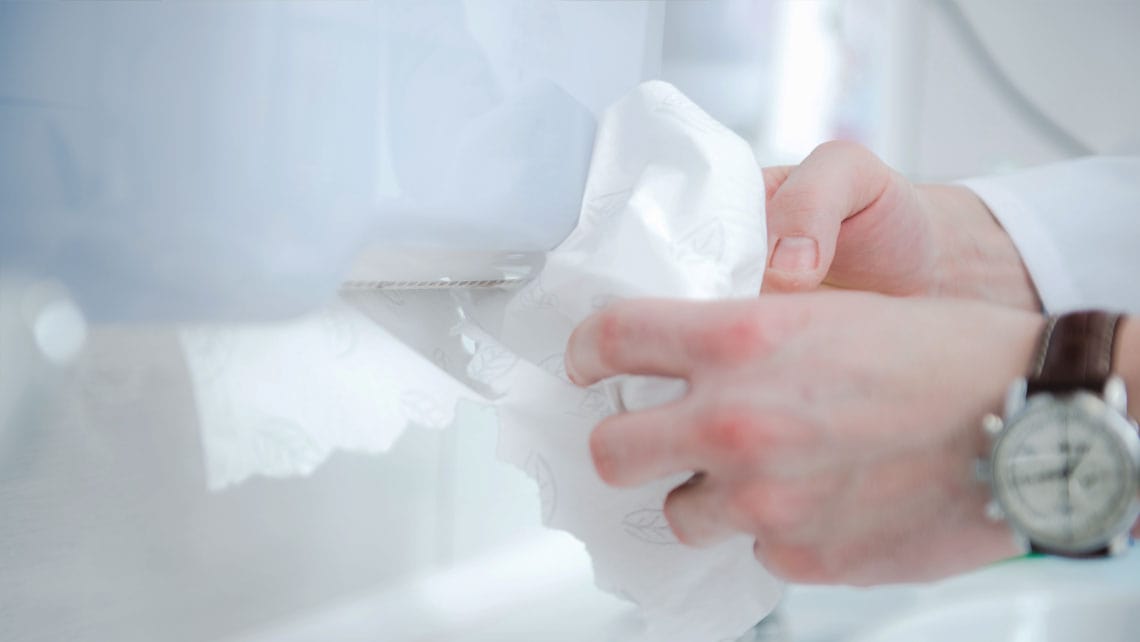In this article, Lucyna Pawlowska, our Principle Specialist for Tissue and Strength shares her advice on how it is possible to increase tissue softness without jeopardizing strength. The secret is in the right combination of chemistries powered by data analytics and insight into the tissue characteristics.
“In tissue products, there is a strong relationship between strength and softness, and furthermore between softness and dust. When making a process change to improve any given tissue property, you need to be aware and understand the full effect of the change and how it might impact other product attributes but also machine efficiency and profitability of the whole tissue making process.”
Tissue softness vs. strength

Softer tissue with dry strength resins
Dry strength additives in tissue and towel production can be the key to improving not only strength, but also softness. Dry strength resins naturally increase dry tensile strength, but in addition, they can have a significant role to play in tissue mills’ softness programs as they provide an opportunity to reduce refining.
“Reduced refining allows for higher sheet bulk, as refining typically has a negative impact on the thickness of the sheet. With that, dry strength resins provide a powerful means for the manufacturers to enhance tissue softness,” Lucyna states. Other benefits of utilizing dry strength resins in tissue production include improved retention and dewatering, which can help increase production efficiency, and lower fines load, which decreases tissue dusting potential and supports a more efficient converting process.
Kemira offers tissue producers a dry strength portfolio of FennoBond™ amphoteric strength technologies and FennoRez™ GPAM-based strength resins, designed to meet the specific requirements of different furnish types, wet end conditions, tissue grade types, and desired tissue end-product properties.
“Our amphoteric strength resin allowed a bath tissue producer to reduce refining and increase the share of eucalyptus fiber in their product to up to 85%, without compromising dry tensile strength. This resulted in a significant increase in overall tissue softness.”
To help manufacturers develop tissue products with superior softness without sacrificing strength, Kemira complements the chemistry portfolio with advanced measurement technologies for tissue quality analysis. KemView™, a patented Sheet Structure Analyzer, delivers an in-depth analysis of different tissue sheet characteristics, which helps study the interdependent tissue properties, optimize the selection of wet end chemistries, and troubleshoot sheet quality and production issues.
Biobased softeners for hand-feel softness
A more typical approach to increasing particularly the hand-feel softness of a tissue product is to use softeners and lotions, either applied on the wet web or as dry sheet spray. Latest additions to Kemira’s FennoSoft™ portfolio are softeners that are manufactured with nonionic, biobased surfactants and lubricants. The newly developed softeners are a more environmentally friendly option to the conventional softeners that are based on imidazolinium surfactants.
The benefit of softeners sprayed on the wet web and dry sheet is that they aren’t as detrimental to tissue dry strength as softeners added into the wet end process. “Laboratory data shows that if softeners are added into the wet end, tissue sheet dry tensile strength is reduced 25–40% more than with softeners that are sprayed on the wet web. What’s more, softeners added to the wet end provide 25–32% lower softness improvement, and can also cause deposits formation on the machine and on the tissue sheet,” compares Lucyna.
Optimizing the crepe control process for softness
The third area to focus on is the crepe control process, which is a key element for softness and also other desired properties in tissue products. Kemira has developed FennoCrepe™ technologies to meet the demand of different furnish types, tissue and towel grades, sheet moisture levels, and Yankee dryer surfaces.
For optimizing both softness and strength, Lucyna highlights Kemira’s patented pre-crosslinked PAE-based creping adhesive that provides a coating of high rewettability and adhesion with medium solubility.
“This product is designed to enable the production of soft tissue of high stretch, while preventing the formation of pinholes in the sheet, which are detrimental to product strength. Thanks to the medium solubility of the coating, it doesn’t wash easily off from the Yankee dryer surface, but doesn’t build up excessively onto it, either.” Coating based on the patented FennoCrepe adhesive also provides very good protection to the Yankee surface and helps extend the creping blade life.
KemView provides insight into the key factors of the sheet structure that are the result of the creping process, such as crepe bars count, uniformity of crepe bars distribution, surface roughness, number of pinholes and free fiber ends, and intensity of sheet marks formed by the forming wire or embossing pattern. This offers opportunities to modify and optimize the creping aids program or blade type and its setup while meeting softness targets. Insight into the fineness of the crepe structure also indicates when it is time to change the creping blade.
Strength in dust control
One of the challenges in the production of soft tissue is dust generation. Sheet dusting and linting cause various problems that can negatively impact operational safety and productivity both at the tissue mill and at the converting plant. Dust can also reduce the final product quality and, through that, end-user satisfaction.
Dry strength resins provide an efficient solution also to this problem: they make the sheet surface stronger by binding loose fibers to the tissue sheet, which reduces dust generation during the tissue making process as well as linting during the end-use of the tissue product.
“There is a clear correlation between strength and the amount of dust in tissue,” Lucyna states. “In a recent customer case, we saw a significant decrease in dust formation after the dosage of synthetic dry strength resins was increased and refining power was reduced.” She discusses the topic and the case in question in more detail in the upcoming Tissue World 2022 conference.
Traditionally, it has been difficult for the tissue producers to quantify the dust and lint in tissue sheet reliably. The new feature of the KemView technology, Dust and Lint Measurement, helps to analyze and measure the total dust and lint particles in the tissue sheet or converted product and, in addition, detect and measure the different categories of particles such as fibers, fines, and starch or ash.





